
أجهزة الملاحة العربية
Your way to more knowledge
Product successfully added to your shopping cart
Quantity
Total
There are 0 items in your cart.
There is 1 item in your cart.
Total products
Total shipping
To be determined
Total
- Countries of the World
- Zip code in Jordan
- List of surahs in the Holy Qur'an
- All flags of the countries of the world
- Traffic signs in Jordan
- Population of world countries by country
- List of world capitals
- Car Brand Logos and Names
- International Calling Codes
- List of currencies of the world
- Country flags of the world with images and names
- Country codes names
- List of countries and dependencies by area
- Al-Quran Recitations mp3
- List of countries and dependencies by population
- World time zones by country
Capital Governorate of Jordan (Amman)
About the Capital Governorate
Also known as: ʿAmmān, Philadelphia, Rabbath Ammon
- Amman Governorate, officially known as Muhafazat al-Asima (Arabic: محافظة العاصمة, English translation: The Capital Governorate) is one of the twelve governorates of Jordan, which includes the most important institutions of the Jordanian state, in addition to all government departments, including the House of Representatives, located in the Abdali area.
- It is the largest governorate in terms of population and the third largest governorate in terms of area after the governorates of Ma'an and Mafraq, the most important of which represents the backbone of the Jordanian state.
- The history of the city of Amman dates back to the seventh millennium BC, and thus it is considered among the oldest inhabited cities in the world to this day. Amman is an ancient city that was built on the ruins of a city known as “Rabbath Ammon,” then “Philadelphia,” then “Amman,” derived from “Rabbath Ammon,” and the Ammonites took it as their capital. The city was established on seven hills, and was apparently the center of the region at that time. It is one of the four capitals of the Levant. It is also one of the ancient Levantine cities that became the capital of the Emirate of Transjordan and then the Hashemite Kingdom of Jordan after its independence in 1946.
- Amman is considered the commercial and administrative center of the Kingdom and its economic and educational heart. It has become a point of attraction for many Arab communities due to its distinguished location and contemporary architecture. It also attracts many tourists annually from Western Europe, North America, Japan, Australia, and from neighboring and nearby Arab countries, and many families from the Arab Gulf countries in particular, as it has many landmarks. Tourism in general and medical treatment in particular. Because of Amman’s location in such a strategic location in the Levant and the Middle East, its location controls the national economy and drives 90% of investment at the national level.
Geographical location
The Capital Governorate (Amman) is located in a central location between the governorates of Zarqa, Balqa, Madaba, Karak and Ma'an, and its borders extend to the Jordanian-Saudi border.
Cities, towns, and villages
Abdoun, Abu Alandah, Adh Dhuhaybah, Al Al, Al Amiriyah, Al Arid, Al Arudah, Al Bahhath, Al Bassah, Al Bunayyat al Janubiyah, Al Bunayyat ash Shamaliyah, Al Hawwasiyah, Al Hummar, Al Jizah, Al Jubayhah, Al Judayyidah, Al Jumayyil, Al Juwayyidah, Al Lubban, Al Mabrak, Al Mahattah, Al Manakhir, Al Mathluthah, Al Muqabalayn, Al Mushaqqar, Al Mushayrifah, Al Mushayrifah, Al Muwaqqar, Al Qartu'iyah, Al Qastal, Al Qunaytirah, Al Qurayyat, Al Quwayjiyah, Al Quwaysimah, Al Yadudah, 'Ammuriya, An Naqubah, An Nuwayjis, 'Ara'ir, Ar Rabahiyah, Ar Rajib, Ar Riwaq, Ash Shufatah, Ash Shumaysani, Ash Shuqayq, As Samik, As Saqrah, Ath Thughrah, 'Atruz, At Tunayb, Barazin, Barzah, Barzah, Bayt Zir'ah, Biddin, Bilal, Buqa'i al-Qababiyah, Dab'ah, Dhiban, Dhuhaybah, Dulaylat al Hama'idah, Dulaylat al Mutayrat, Halaq ash Shuqayq, Hawwarah, Hisban, Iraq al Amir, Jalul, Jawa, Juraynah, Khilda, Khirbat 'Assaf, Khirbat as Sahilah, Khirbat Badran, Khirbat Khaww, Khirbat Siran, Khuraybat as Suq, Kufayr Abu Sarbut, Kufayr al Wakhyan, Kufayrat Abu Khinan, Madaba, Ma`in, Manja, Marka, Mukawir, Mulayh, Murayjimat Ibn Hamid, Natl, Na'ur, Qasr al Hallabat, Qubur 'Abd Allah, Qurayyat Falhah, Qurayyat Nafi', Qurayyat Salim, Rujaym Salim, Rujm ash Shami, Rujm ash Shara'irah, Sahab, Shunat Ibn 'Adwan, Sufah, Sumiya, Suwaylih, Tabarbawr, Tila' al 'Ali, Umm al 'Amad, Umm al Birak, Umm al Hanafish, Umm al Kundum, Umm al Qanafidh, Umm ar Rasas, Umm as Summaq, Umm Juraysat, Umm Nuwarah, Umm Qusayr, Umm Qusayr, Umm Rummanah, Umm Shujayrah al Gharbiyah, Umm Zuwaytinah, 'Urjan al Gharbiyah, 'Urjan ash Sharqiyah, 'Uyun adh Dhi'b, Wadi as Sir, Yajuz, Zaba'ir 'Udwan, Zuwayza.
Climate
The climate of the Capital Governorate (Amman) is generally moderate, as a Mediterranean climate prevails in most areas of the capital, especially in the highlands. While some of its regions have a semi-desert climate, especially in the eastern regions. Temperatures rise in summer, reaching their highest levels in mid-August, sometimes reaching the mid-30s Celsius. The temperature drops in winter, sometimes reaching zero or below zero in January, which causes snow to fall on the highlands. The climate is mild in the spring and fall.
Amman – a unique blend of antique and novel
This city that seamlessly blends the past and the present, offering a captivating blend of history, culture, and modernity. As you wander through the bustling streets, explore ancient ruins, or savor the flavors of Jordanian cuisine, you can’t help but be entranced by the city’s unique charm.
Amman has a wealth of famous archaeological monuments that still bear witness to ancient civilizations that settled the city. On the Citadel Mountain, which rises above the old city, rises the “Temple of Hercules,” which was built by the Romans in the second century AD on the remains of an ancient Ammonite temple, in addition to the Antiquities Museum, which contains many exhibits. From various civilizations and tools representing human life in these ancient times. In the center of the city is the Avenue of the Nymphs, and close to the Avenue stands the large Roman amphitheater that can accommodate five thousand spectators, and other landmarks that are used to this day in many cultural and artistic events. They are among the centers that the Jordan Festival exploits and organizes its events.
Amman has a wealth of famous archaeological monuments that still bear witness to ancient civilizations that settled the city. On the Citadel Mountain, which rises above the old city, rises the “Temple of Hercules,” which was built by the Romans in the second century AD on the remains of an ancient Ammonite temple, in addition to the Antiquities Museum, which contains many exhibits. From various civilizations and tools representing human life in these ancient times. In the center of the city is the Avenue of the Nymphs, and close to the Avenue stands the large Roman amphitheater that can accommodate five thousand spectators, and other landmarks that are used to this day in many cultural and artistic events. They are among the centers that the Jordan Festival exploits and organizes its events.
- Roman amphitheaterRoman amphitheater (Amman)
 (almadraj alruwmaniu)
(almadraj alruwmaniu)
The Roman Theatre in Amman is a grand 6,000-seat amphitheater that stands as a testament to the architectural prowess of the Roman Empire. Constructed in the 2nd century AD, it is carved into the northern side of a hill and oriented to keep the sun off spectators. The theatre is still used today for cultural events and performances, showcasing its enduring legacy. It is part of a larger complex that includes a smaller Odeon theatre and a museum, offering visitors a glimpse into the rich history of the region. The theatre is complemented by two small museums on-site, the Folklore Museum and the Jordanian Museum of Popular Traditions, which offer insights into the cultural heritage of Jordan. The museums showcase artifacts, costumes, and daily life items, providing a deeper understanding of the region's history. Coordinates: 31°57′06.09″N 35°56′21.50″E
- Amman Citadel (جبل القلعة, Jabal al-Qal'a) (Umayyad palace, Jordan Archaeological Museum)
- jabal alqaleatjabal alqaleat (Amman)
 is an ancient historical site located in the heart of Amman. It is one of the oldest continuously inhabited places in the world, with evidence of occupation dating back to the Bronze Age. The Citadel is home to several significant archaeological structures, including the Roman Temple of Hercules, the Byzantine Church, and the Umayyad Palace. Visitors can explore the ruins and enjoy panoramic views of the city from its elevated position. The site also houses the Jordan Archaeological Museum, which displays artifacts from various periods of Jordan's history.
is an ancient historical site located in the heart of Amman. It is one of the oldest continuously inhabited places in the world, with evidence of occupation dating back to the Bronze Age. The Citadel is home to several significant archaeological structures, including the Roman Temple of Hercules, the Byzantine Church, and the Umayyad Palace. Visitors can explore the ruins and enjoy panoramic views of the city from its elevated position. The site also houses the Jordan Archaeological Museum, which displays artifacts from various periods of Jordan's history.
See the sunset from the view point near the Citadel. But pay also your attention to the time of the muezzin call. If you listen to it from the view point, where the whole city lies before you, you get the unforgettable acoustic impression. Coordinates: 31.9547°N 35.9343°E - Umayyad PalaceUmayyad Palace (Amman)
(Arabic: القصر الأموي) (in the citadel) is a remarkable example of early Islamic architecture, dating back to the 8th century. Situated within the Amman Citadel, this historical site offers a glimpse into the grandeur of the Umayyad dynasty. The palace complex includes a large audience hall, a colonnaded street, and a domed entrance chamber, showcasing the architectural ingenuity of the period. Coordinates: 31.9555°N 35.9342°E
- Jordan Archaeological Museum (in the citadel) was established in 1952 to tell the story of Jordanian civilization through displaying archaeological and historical collections. It contains collections of artefacts that were collected from different sites across Jordan. The artefacts were chronicled starting from The Palaeolothic Age up to Islamic Age, including pottery, metal and glass artefacts, in addition to inscriptions, coins and statues. The top exhibits of the museum are the plaster statues of ʻAyn Ghazāl.
- jabal alqaleatjabal alqaleat (Amman)
- Qasr Al-AbedQasr Al-Abed (Amman)
 (Arabic: قصر العبد, lit. 'Castle of the servant')
(Arabic: قصر العبد, lit. 'Castle of the servant')
Qasr al-Abd, It is located in Jordan in Wadi Al-Seer, near the village of Iraq Al-Amir, approximately 17 kilometers west of Amman, Jordan. This Hellenistic-era palace, believed to have been constructed by the Tobiad family, offers a unique glimpse into ancient architecture and history, distinct from the more commonly seen Roman and Umayyad structures in the region. The site is renowned for its well-preserved ruins, intricate carvings, and the surrounding natural beauty, making it a worthwhile destination for history enthusiasts and nature lovers alike.
In addition to the palace itself, the area offers several other attractions. Nearby caves, accessible by a short climb, provide further historical intrigue with their ancient inscriptions and evidence of past human habitation. The Iraq Al-Amir Women’s Cooperative, located in the vicinity, offers a chance to purchase local ceramics and paper products, adding a cultural dimension to the visit. Coordinates: 31.9128°N 35.7518°E
- Grand Al-Husseini MosqueGrand Al-Husseini Mosque (Amman)
 (Arabic: المسجد الحسيني الكبير)
(Arabic: المسجد الحسيني الكبير)
The Grand Husseini Mosque, built in 1924, stands as a prominent religious and historical landmark in Amman, Jordan. Constructed on the site of an ancient mosque from the Umayyad period, it was commissioned by King Abdullah I. The mosque is renowned for its striking Ottoman architectural style, featuring a large prayer hall, elegant minarets, and a spacious courtyard. It serves as a central place of worship for the local Muslim community and is a significant cultural and historical site for visitors. The mosque's location in the bustling downtown area of Amman makes it easily accessible for those exploring the city's rich history and vibrant culture.
Located at the heart of downtown Amman, the mosque stands on the site of an earlier mosque that was built during the reign of Caliph Omar Ben Al Khattab’s (634-644 AD) and renovated during the Umayyad era (661-750AD), the documents show. Coordinates: 31.9496326°N 35.932045°E
- The King Abdullah I MosqueThe King Abdullah I Mosque (Amman)
 (Arabic: مسجد الملك عبد الله الأول)
(Arabic: مسجد الملك عبد الله الأول)
Is a mosque, located in Amman, Jordan. Named in honour of Abdullah I, the mosque was built between 1982 and 1989 and is capped by a blue mosaic dome beneath which 3,000 Muslims may offer prayer. It is in the Abdali area of the city.
Tourists are allowed to visit. Men must have long trousers on and women must cover their heads, arms and legs. A hooded gown is provided free of charge for this purpose. Coordinates: 31°57′42″N 35°54′47″E
- Abu Darwish MosqueAbu Darwish Mosque (Amman)
 (مسجد أبو درويش)
(مسجد أبو درويش)
The Abu Darwish Mosque, located on Jebel al-Ashrafiyeh, one of Amman’s seven hills, is a striking architectural landmark known for its unique black and white stone facade. Built in 1961, the mosque stands out due to its Ottoman style and Levantine influence, making it a visually captivating site. The mosque's design, featuring alternating rows of black and white stones, is reminiscent of traditional Syrian architecture, and it is a testament to the cultural and historical influences in the region. The mosque was funded by Abu Darwish (Mustafa Hassan), who was born in the Caucasus and embraced Syrian architectural styles.
While the mosque is a place of worship and not primarily a tourist destination, its exterior is a major draw for visitors.
The Abu Darwish Mosque is not just an architectural marvel but also a place of peace and reflection. It accommodates more than 7,000 worshippers and includes a small Islamic museum, a library with over 3,000 books, and a school for teaching the Holy Quran. The mosque also played a role in the unification of the call to prayer (azaan) in Amman, with the first unified call broadcast from this location. Coordinates: 31°56′29″N,35°56′15″E
- Cave of the people of the cave (kahaf 'ahl alkahf)
Cave of the people of the cave in Amman, Jordan, is a religious and historical site that is well worth a visit for those interested in the story mentioned in the Quran and Bible. The site is well maintained and easily accessible, with a mosque nearby for prayer. The cave itself is small but contains the graves of the seven sleepers, with one tomb displaying bones that can be viewed with a flashlight. The site is not heavily touristy, providing a peaceful and serene atmosphere for reflection.
This cave was identified with the Qur'anic record due to the name of the nearby village, al-Rajib, which is etymologically similar to the word al-Raqīm mentioned in al-Kahf.
also known Qur’an as the "Companions of the Cave" (Arabic: اصحاب الكهف) — a group of young men who, according to Islamic and Christian sources, fled the religious persecution of Roman emperor Decius. Legend has it that these men hid in a cave around AD 250, emerging miraculously centuries later - according to the Quran, 309 lunar years later. Rediscovered in 1951.
The on-site guide, usually an Imam, provides informative tours in both Arabic and English, offering insights into the history and significance of the cave. The site is free to enter, making it accessible to all visitors.
Overall, visitors describe Cave of the people of the cave as a must-visit destination for those interested in religious history and seeking a unique and meaningful experience. The site's connection to the Quran and the story of the seven sleepers adds a layer of depth and significance to the visit. The well-preserved graves, the informative guide, and the peaceful atmosphere all contribute to a memorable and enlightening experience for visitors. Whether you are a Muslim looking to connect with your faith or a history enthusiast seeking to explore ancient stories, Cave of the people of the cave offers a compelling and enriching experience that is worth the visit. Coordinates: 31°53'55.0"N 35°58'24.0"E
- Jordan MuseumJordan Museum (Amman)
 (Arabic: متحف الأردن)
(Arabic: متحف الأردن)
The Jordan Museum is located in Ras Al Ain area, in the heart of Amman, where the main buildings of the Greater Amman Municipality and the capital’s cultural facilities are also located. Is one of the best in the Middle East. Housed in a grand modern building, a series of beautifully presented and informative displays tell Jordan's historical epic from the first people through the Nabataean civilisation to the cusp of the modern era. Visitors can walk throughout the exhibitions following the story in chronological order to gain a deeper understanding. Beyond this, the exhibits are well organized in terms of their genres such as architecture, food, art or ways of life and culture. Several historical artifacts that are highlighted in the museum include the oldest human statues in human civilization, dating back to 7500 BC ‘Ain Ghazal statues are a marvel. Additionally, the Dead Sea scrolls are housed in the museum which includes the only copper scroll. All displays we well designed, detailed and thoughtfully laid out with both English and Arabic descriptions on every item. Coordinates: 31°56'43.3"N 35°55'33.3"E
- Roman Nymphaeum (sabil alhuriaat / سبيل الحوريات)
The nymphaeum was built in the 2nd century CE, during the same period as the nearby theatre and odeon.
It used to be located along the Seil Amman, a water stream that had dried up in the 20th century. The Nymphaeum is located a short distance from other Roman ruins, including a forum (in the location of today's Hashemite Plaza), the Roman Theater and the Odeon.
Nymphaeum Roman cities always contained ornamental fountains, where water has always played such an important role, and Philadelphia, as Amman was known by ancient Greeks and Romans, was no exception. The main fountain or Nymphaeum, dedicated to the water nymphs, is close to the theater complex and dates back to 191 AD.
It is at the crossing of Ibn al-Atheer and Quraysh streets in downtown area. Coordinates: 31°57'01.2"N 35°56'10.2"E
- Ammonite Watchtower (Rujm Al-Malfouf in Wadi Saqra)
A circular watchtower built by the Ammonite kingdom some time between 500-1000 BC.
- Ten Arches BridgeTen Arches Bridge (Amman)
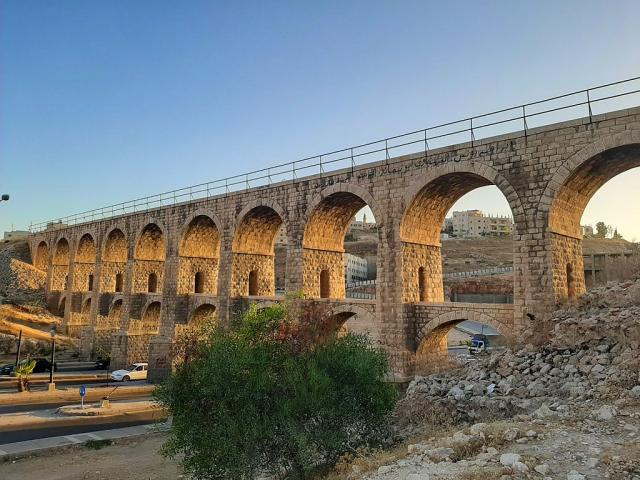 (Arabic: الجسور العشرة)
(Arabic: الجسور العشرة)
Is a viaduct in Amman, Jordan that was built as part of the Hejaz Railway during the Ottoman Empire. It is considered one of Amman's old landmarks.
The bridge is made of two-floor arches of limestone blocks, with the upper one made of ten arches containing the railway, and the lower one made of eight arches consisting of a pedestrian path and water drainage channels.
The bridge is considered one of Amman's old landmarks, and is still used by trains used in the Hejaz Railway.
Completed in 1908 when the Amman station was inaugurated, it became a primary target for destruction by Allied forces during a World War I attack, which did not succeed. A structural analysis in 2022 showed the bridge could still withstand loads, but might be damaged by a b earthquake. Coordinates: 31°56′21″N 35°57′22″E
- Royal Automobile Museum (Arabic: متحف السيارات الملكي)
Located next to the Al Hussein Public Parks, the museum was established in 2003 upon King Abdullah's wishes. The museum showcases a rare collection of Jordan's vehicles ranging from Hussein bin Ali's cars that came to Amman in 1916 to modern sports cars.
The museum has the rover used in filming of Hollywood's movie The Martian, which used Jordan's UNESCO world heritage site Wadi Rum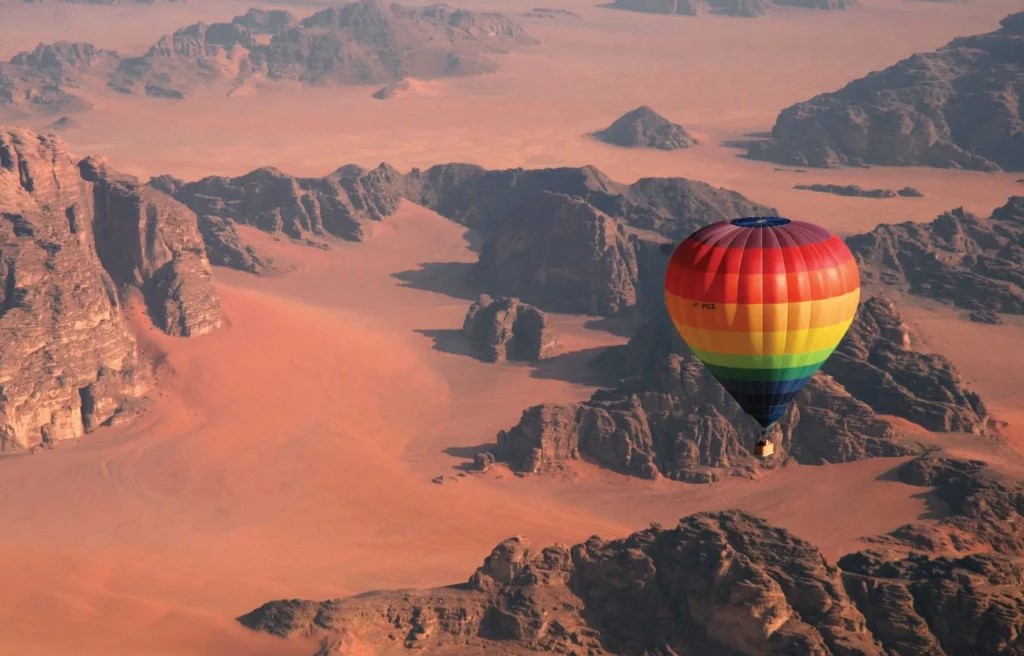
Wadi Rum (Arabic: وادي رم Wādī Ramm, also Wādī al-Ramm), known also as the Valley of the Moon (Arabic: وادي القمر Wādī al-Qamar), is a valley cut into the sandstone and granite rock in southern Jordan, near the border with Saudi Arabia and about 60 km (37 mi) to the east of the city of Aqaba. With an area of 720 km2 (280 sq mi) it is the largest wadi (river valley) in Jordan.
Several prehistoric civilizations left petroglyphs, rock inscriptions and ruins in Wadi Rum. Today it is a tourist attraction, offering guided tours, hiking and rock climbing. The Wadi Rum Protected Area has been a UNESCO World Heritage site since 2011. as the backdrop for the Martian scenes. The rover was gifted to Jordan in return for the hospitality with which Jordan extended to the movie cast and crew. Coordinates: 31.9842°N 35.8257°E
- Rainbow Street (Arabic: شارع الرينبو)
Near the 1st Circle in Jabal Amman, this is an interesting area to walk around and explore, it is named after the old Rainbow Cinema which is now out of use, but the area has experienced a revival with many of the old houses being restored and put into use, in the area there are some cafes and a Caribbean restaurant, an Indian restaurant, a sushi joint, and an ice cream shop. And the Royal Film Commission which sometimes holds outdoor screenings on its patio and some interesting small shops. Coordinates: 31.950618°N 35.923107°E
Jordanian cuisine
Jordanian food is known for being full of flavour. Jordan’s cuisine is a blend of Middle Eastern and Mediterranean influences and uses ingredients like spices, herbs, lamb, chicken, rice, yoghurt, chickpeas and olive oil.
Popular foods in Jordan:
Popular foods in Jordan:
- MansafMansaf
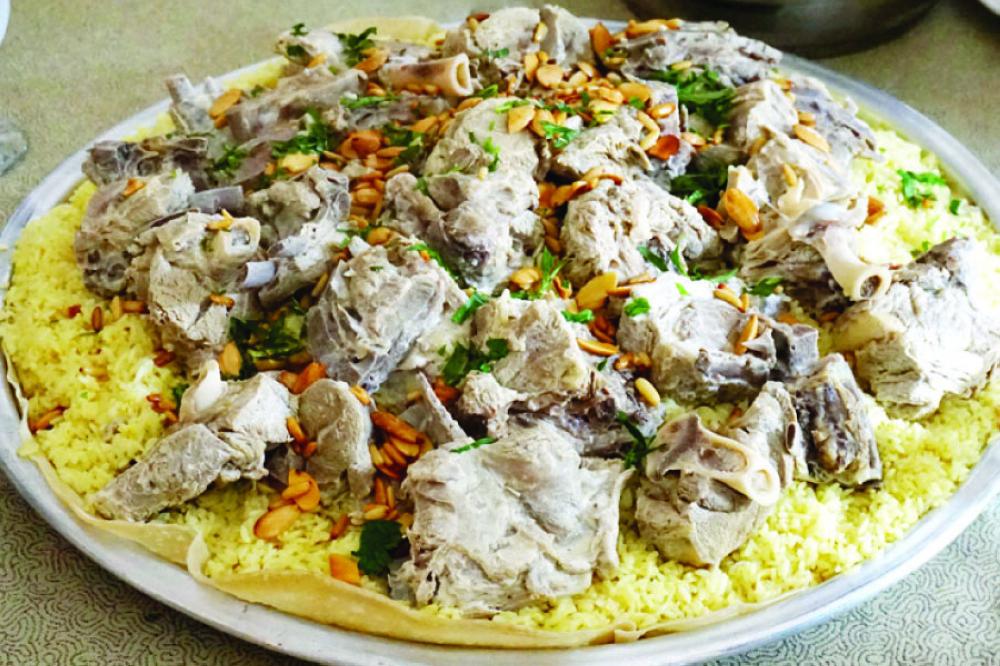 (المنسف): Mansaf is considered the national dish in Jordan. It is known in all regions without exception. It is served on occasions such as wedding banquets, holidays, and at funeral tables as well.
(المنسف): Mansaf is considered the national dish in Jordan. It is known in all regions without exception. It is served on occasions such as wedding banquets, holidays, and at funeral tables as well. - MakmouraMakmoura
 : It is a well-known dish in the villages of northern Jordan.
: It is a well-known dish in the villages of northern Jordan. - Kibbeh or kebab: It is one of the dishes that is prepared in all regions, as its spread extended from the villages north of Irbid, such as the villages of Bani Kenana.
- Al-MutabbaqAl-Mutabbaq
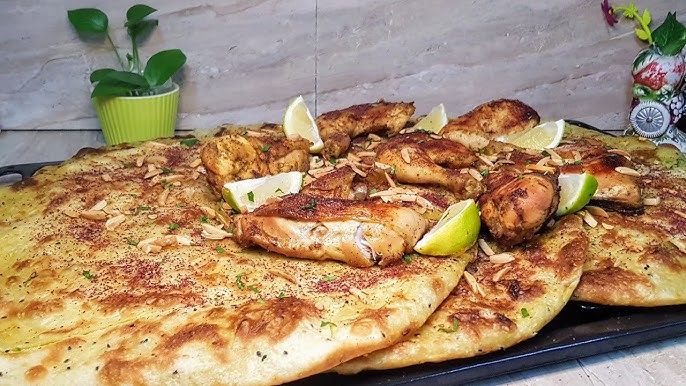 (Mutabbaq): It is known as one of the good dishes in the villages of Al-Taybeh and Al-Wasatiya Districts, and it is smaller than Al-Makmoura.
(Mutabbaq): It is known as one of the good dishes in the villages of Al-Taybeh and Al-Wasatiya Districts, and it is smaller than Al-Makmoura. - Maqluba/MaglubaMaqluba/Magluba
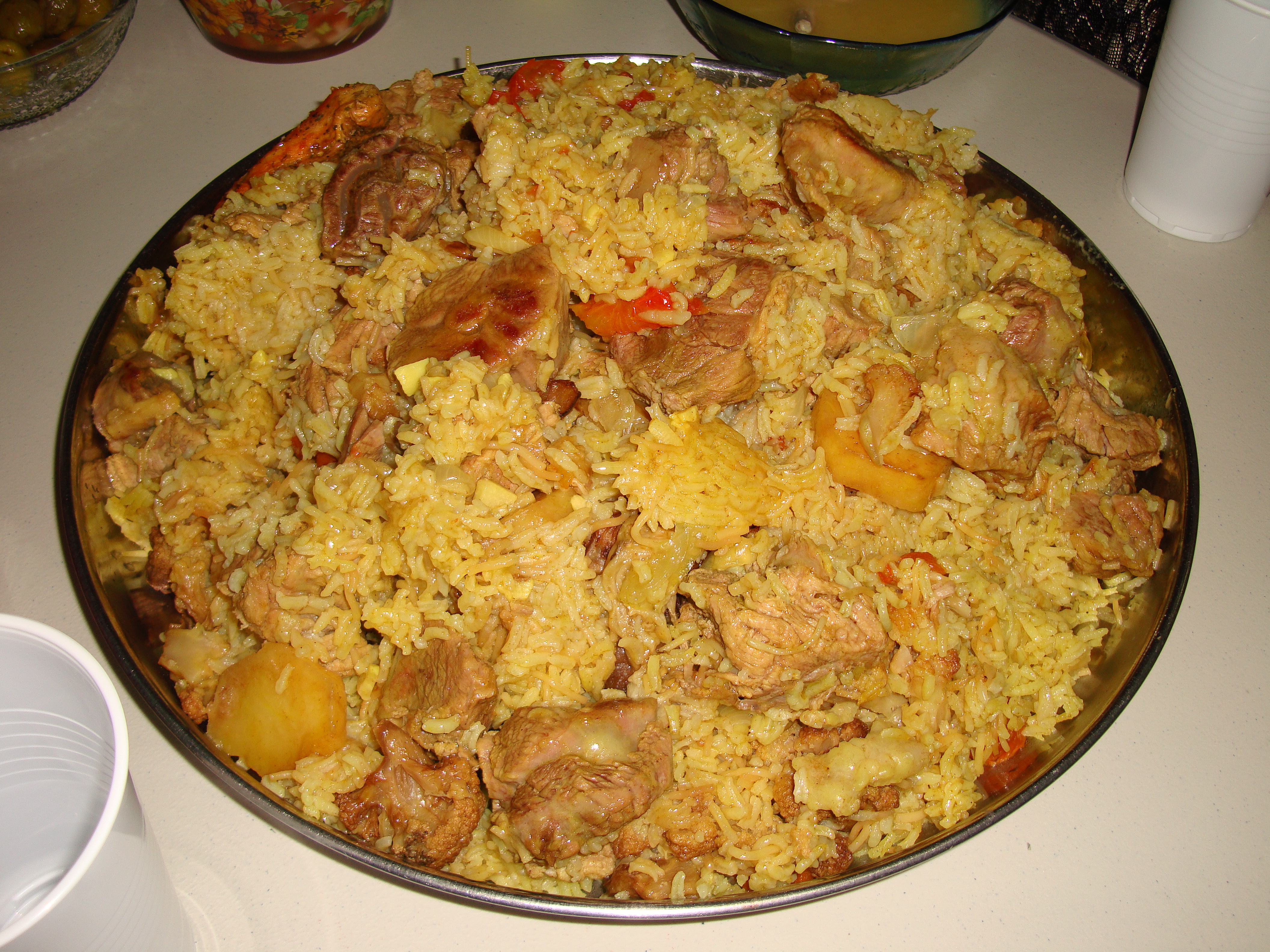 (مقلوبة): A casserole made of layers of rice, vegetables and meat. After cooking, the pot is flipped upside-down onto the plate when served, hence the name maqluba which translates literally as "upside-down".
(مقلوبة): A casserole made of layers of rice, vegetables and meat. After cooking, the pot is flipped upside-down onto the plate when served, hence the name maqluba which translates literally as "upside-down". - MusakhanMusakhan
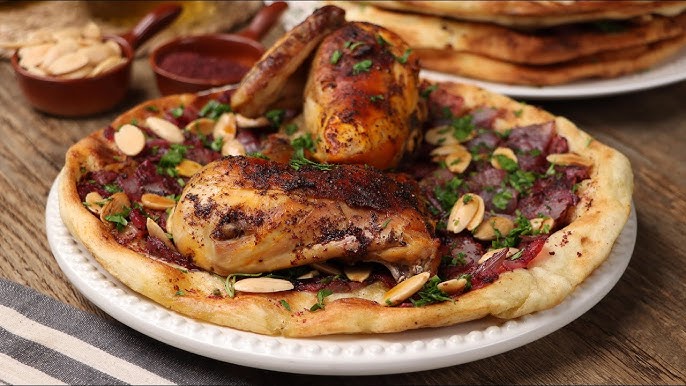 (مسخّن): Dish composed of roasted chicken baked with onions, sumac, allspice, saffron, and fried pine nuts served over taboon bread. It is also known as muhammar (Arabic: محمر).
(مسخّن): Dish composed of roasted chicken baked with onions, sumac, allspice, saffron, and fried pine nuts served over taboon bread. It is also known as muhammar (Arabic: محمر). - MaftulMaftul
 (مفتول): Large couscous-like balls, garbanzo beans and chicken pieces cooked in chicken broth.
(مفتول): Large couscous-like balls, garbanzo beans and chicken pieces cooked in chicken broth. - aldafin Freekeh (فريكة)
- Al-JajilAl-Jajil
 (Kaakil or Shaashil), all Jordanian governorates share the same popular dishes, due to the similarity between the regions and are considered one of the popular dishes.
(Kaakil or Shaashil), all Jordanian governorates share the same popular dishes, due to the similarity between the regions and are considered one of the popular dishes. - ShishbarakShishbarak
 (ششبرك): Also known as Joshpara. A sort of dumpling or jiaozi dish. After being stuffed with ground beef and spices, thin wheat dough parcels are cooked with jameed then served hot. Another name for this dish is shishbarak.
(ششبرك): Also known as Joshpara. A sort of dumpling or jiaozi dish. After being stuffed with ground beef and spices, thin wheat dough parcels are cooked with jameed then served hot. Another name for this dish is shishbarak. - Galayet bandoraGalayet bandora
 (قلاية بندورة): Tomatoes sauteed and stewed with onions, olive oil, salt, and hot peppers, it can be served with rice but is more commonly eaten with bread in Jordan,It is indispensable for all classes of people in all governorates.
(قلاية بندورة): Tomatoes sauteed and stewed with onions, olive oil, salt, and hot peppers, it can be served with rice but is more commonly eaten with bread in Jordan,It is indispensable for all classes of people in all governorates. - FalafelFalafel
 (فلافل): Balls of fried chickpea flour and Middle Eastern spice. Dipped in every mezze, especially hummus. The Jordanian falafel balls tend to come in smaller sizes.
(فلافل): Balls of fried chickpea flour and Middle Eastern spice. Dipped in every mezze, especially hummus. The Jordanian falafel balls tend to come in smaller sizes. - Hummus, Ful medamesHummus, Ful medames
 (حمص وفول مدمس): These are foods usually served for breakfast, especially on Fridays. They are also served as appetizers for lunch and dinner.
(حمص وفول مدمس): These are foods usually served for breakfast, especially on Fridays. They are also served as appetizers for lunch and dinner.
Sweets
- BaklavaBaklava
 (بقلاوة)—a dessert made with thin layers of phyllo pastryphyllo pastry
(بقلاوة)—a dessert made with thin layers of phyllo pastryphyllo pastry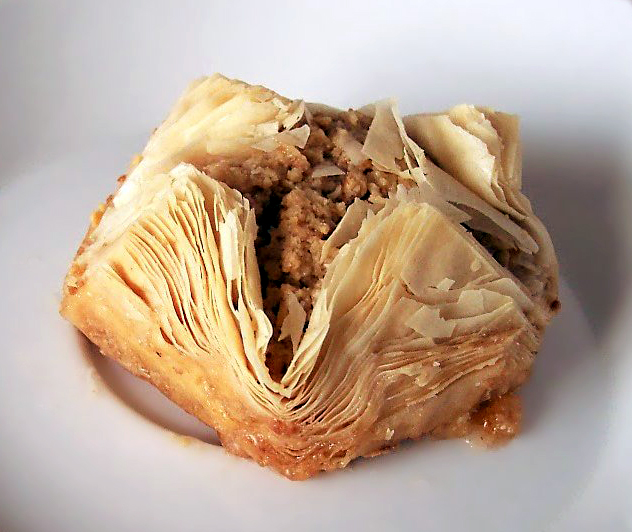 filled with chopped nuts and soaked in honey or syrup.
filled with chopped nuts and soaked in honey or syrup. - KnafehKnafeh
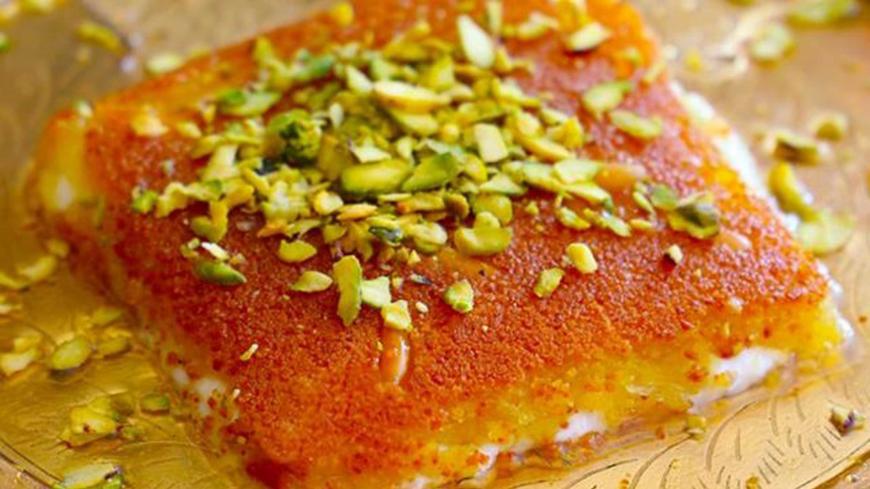 (كُنافة)—a cheese pastry of shredded phyllo soaked in sugar-based syrup.
(كُنافة)—a cheese pastry of shredded phyllo soaked in sugar-based syrup. - QatayefQatayef
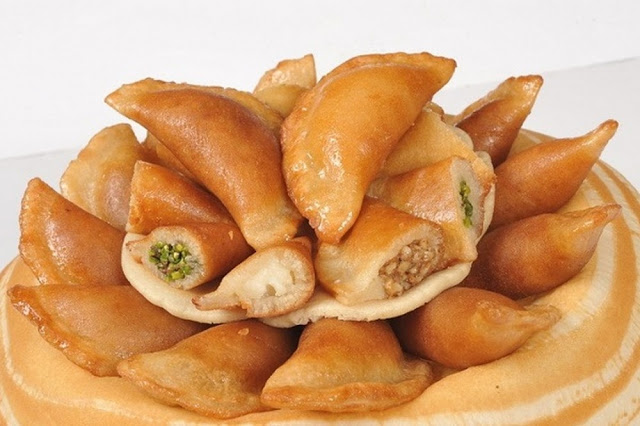 (قطايف)—a sweet dumpling stuffed with cream and pistachios. Consumed during Ramadan.
(قطايف)—a sweet dumpling stuffed with cream and pistachios. Consumed during Ramadan. - WarbatWarbat
 (وربات)—a pastry of thin layers of phyllo pastry filled with custard. Often eaten during the month of Ramadan.
(وربات)—a pastry of thin layers of phyllo pastry filled with custard. Often eaten during the month of Ramadan.
Area and population
- Population of Capital Governorate: (4,744,700) people
- Governorate area: (7,579 km²) (2,926 mi²)
